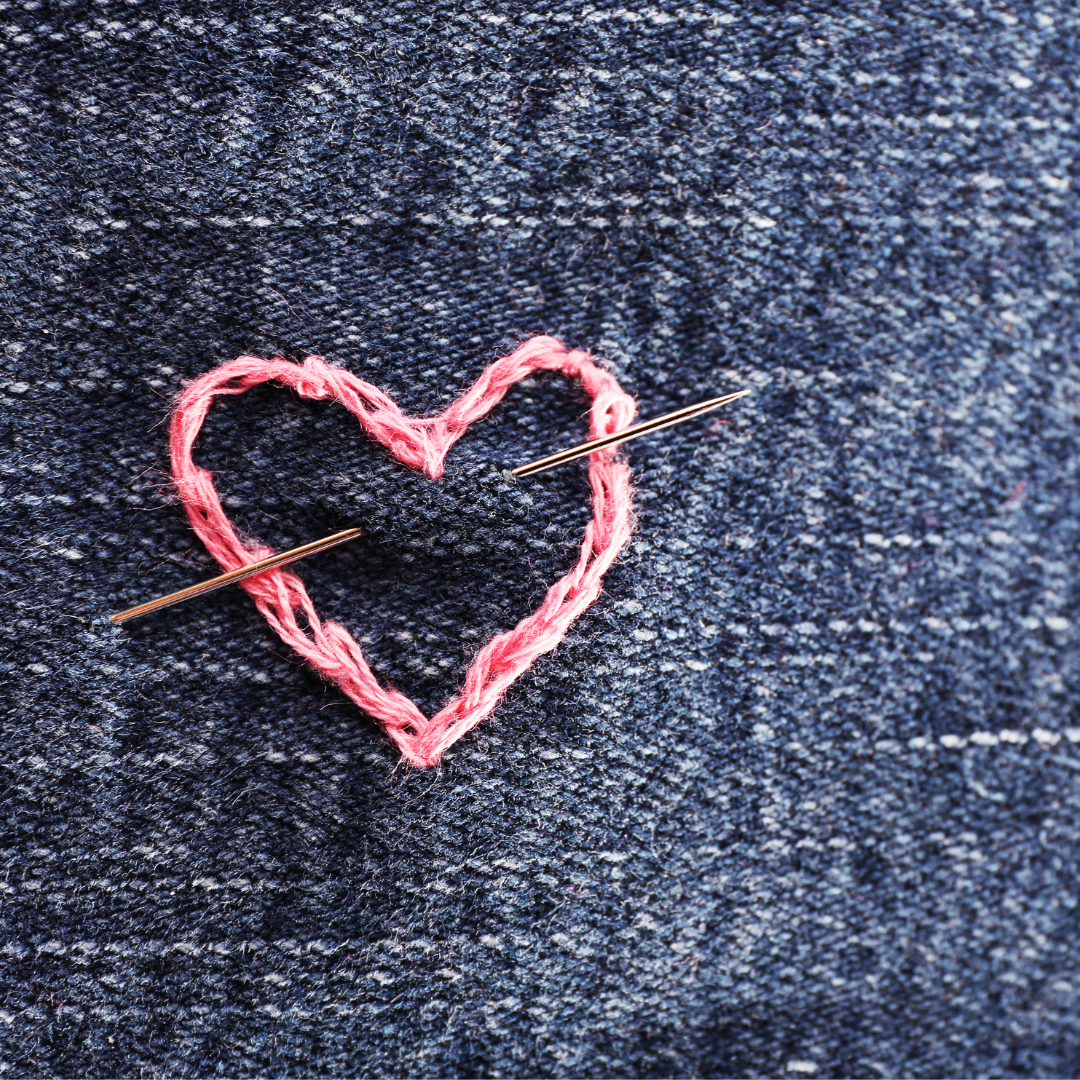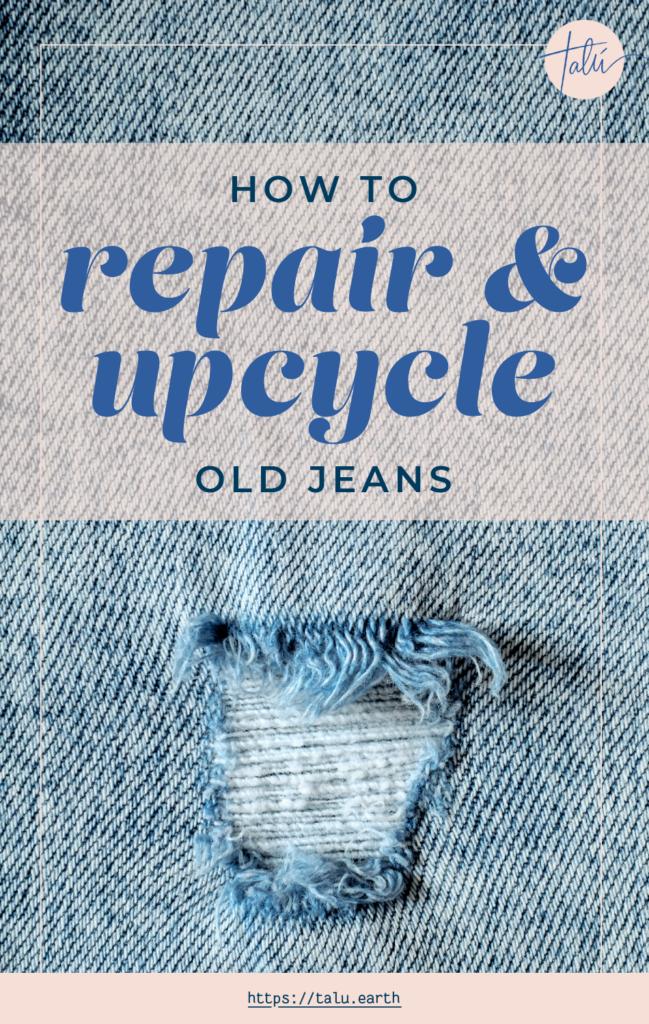Jeans, much like people, have personalities that can get better with time. Denim is one of those fabrics that is hugely popular for very good reason. Learning how to repair jeans can keep this incredible textile alive for decades.
“Old” doesn’t mean “bad”, especially when we’re talking about clothes. In fact, great craftsmanship and hardy materials are a testament to the power of plants.
I’m in love with the intricacies of textiles, fabrics, and fibres, and few come close to the durability and versatility of good old denim jeans.
Chances are, you own a few pieces–and if you’re keeping up with the current trends, they might even be vintage! True vintage jeans are easier to come across than most other clothing, because they just last so well.
Even when you get a new pair of jeans, the sustainability mindset means that you should intend to wear them long enough for them to become vintage someday.
With just a little help along the way, your jeans can stand the test of time.

Like all fabrics, denim sometimes hits snags–so learn the most common sewing stitches to learn how to repair jeans and small holes.
Small holes in jeans are often ignored. They can bring character and life into a piece of clothing–just ask the decade-long trend of ripped jeans!
But, that might not be your style, or the hole might be in a particularly inconvenient place.
Read my article on how to mend small holes to learn the stitches you’ll need to sew your jeans right up, good as new!
If you don’t feel like sewing up your jeans, “patch” them up!
So you’re bored of your jeans and don’t like wearing them as much anymore, or there are holes you don’t feel like sewing. It happens.
Attaching store bought iron-on embroidered patches can bring your jeans to life with personality! This retro trend is back in a big way, and I for one love it.
Don’t shell out for new designer clothes or reach for fast fashion jeans with patches–just make your own with the denim you already have. Check out this video for learning how to patch your jeans.
If you don’t want to sew, but also want the patches to be low-key, you can use iron-on denim patches to reinforce or disguise the holes instead. 0
Use embroidered stitching or sew your own patches for an edgier look.
Intentional “rough around the edges” is one of my favourite styles, and embroidery stitches and rough-hewn sew-on patches definitely fit the bill.
This Better Homes & Gardens article covers the basics of “visible mending”. It’s a great start!
If you’re interested in learning a few easy embroidery stitches, start slow.
If it grips you, you might have just found a new hobby. YouTube (TikTok, and Instagram, and the internet as a whole) is full of passionate sewers who will show you the ropes (or, threads).
One of the best ideas I’ve seen is to use old denim scraps from other projects, and use that contrast to make new denim patches!
With enough pieces, this makes a patchwork denim look that I think is super interesting and playful.

Cut the ragged legs off of old jeans and make jean shorts.
Jean shorts, affectionately termed “jorts”, aren’t going anywhere.
Raw-hem denim jean shorts are adorable, casual, and sustainable. You can roll the edges if you prefer a cleaner look, and even sew them down that way.
Keep the scraps of your old trouser legs, because you can use them for the next idea.

When your jeans are too far gone, upcycle the scraps.
You don’t have to throw your old fabric away! You can upcycle the scraps into all sorts of projects.
Read my article on 5 ways to upcycle fabric scraps at home for tons of ideas and links to super easy step-by-step YouTube videos!
If you want an easier answer, I also go into recycling programs and where you can recycle your old fabrics.

Naturally dye your stained denim jeans to give them new life.
My passion is using natural dyes to breathe new life into old clothing.
Whether your jeans aren’t your style anymore or you want to dye them to hide stains and uneven tones, I can help out.
If your jeans are made of 100% cotton and no plastics, you can use natural dyes to completely transform them! I wrote about how to dye clothes naturally with step-by-step instructions already.
Old jeans are typically already dyed, often with synthetic dyes, so re-colouring might be tricky. For example if the jeans are dyed blue and you dye them yellow, they’ll turn a shade of green or teal, so you should bear in mind that the result will be a mix of both colours. Experimentation is key!
Natural dyeing is a fun, sometimes unpredictable process. It’s all part of the joy of learning how to use the world around you to create new gorgeous colours and materials.
Learning how to repair jeans is an amazing step towards sustainability.
Repairing the clothing we already own is an incredible commitment to living slowly, appreciating our items, and getting in touch with our relationship to the earth’s natural cycles.
The act of repairing your belongings, especially fashion, is in itself a stand against overconsumption and mindless waste.
If you’re here, you’re already doing wonderfully.
Creating your own sustainable wardrobe is a lifelong process. After all, the first step is educating yourself–but then again, so is the last. There’s always more to learn.
For more intricate, specific details on how to successfully dye your own jeans (and all other natural fibres), take my Living Colours with the Five Elements natural dyeing workshop!
I’ll teach you everything you need to know to go forth into the world of sustainability with confidence.
Pin this post!
